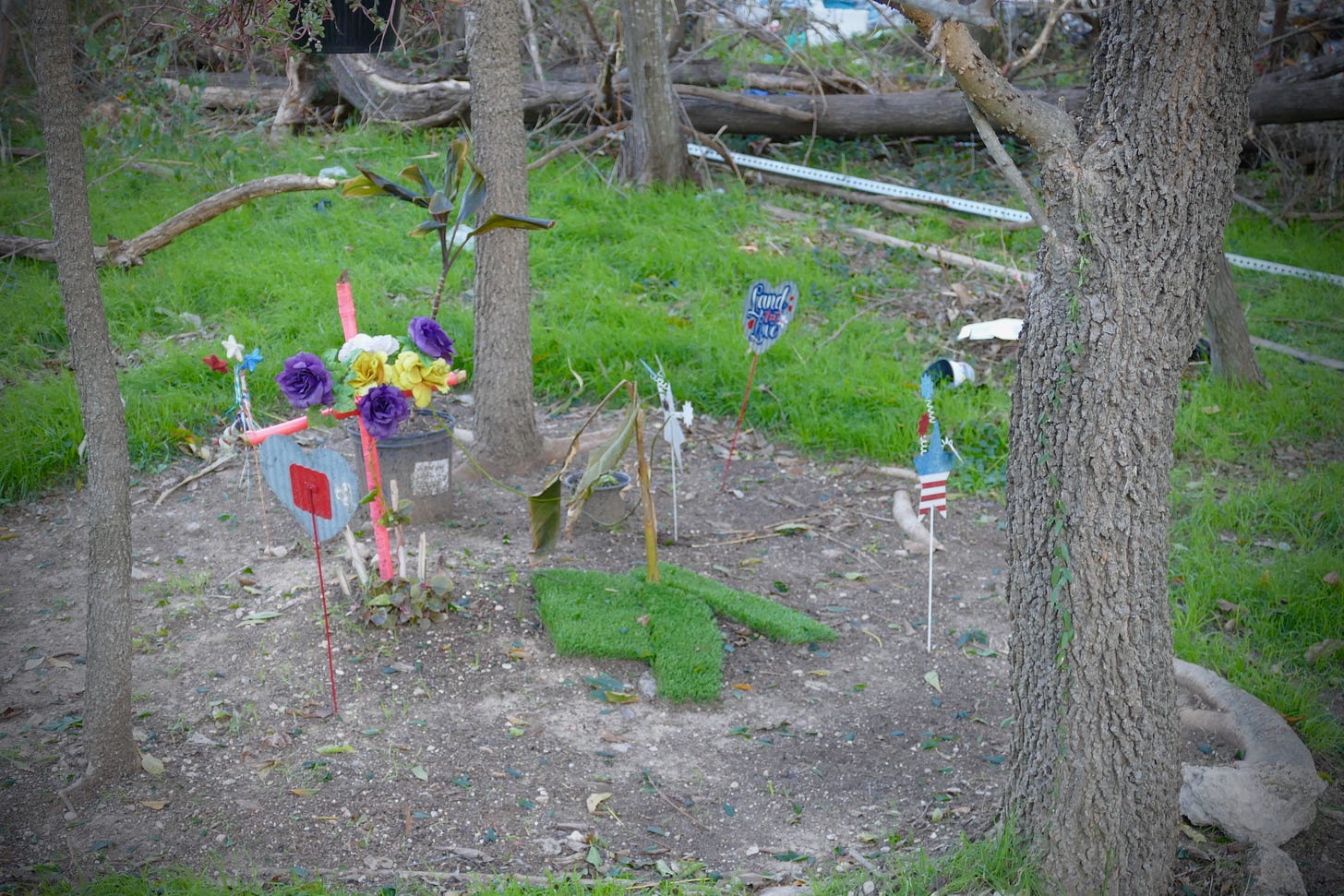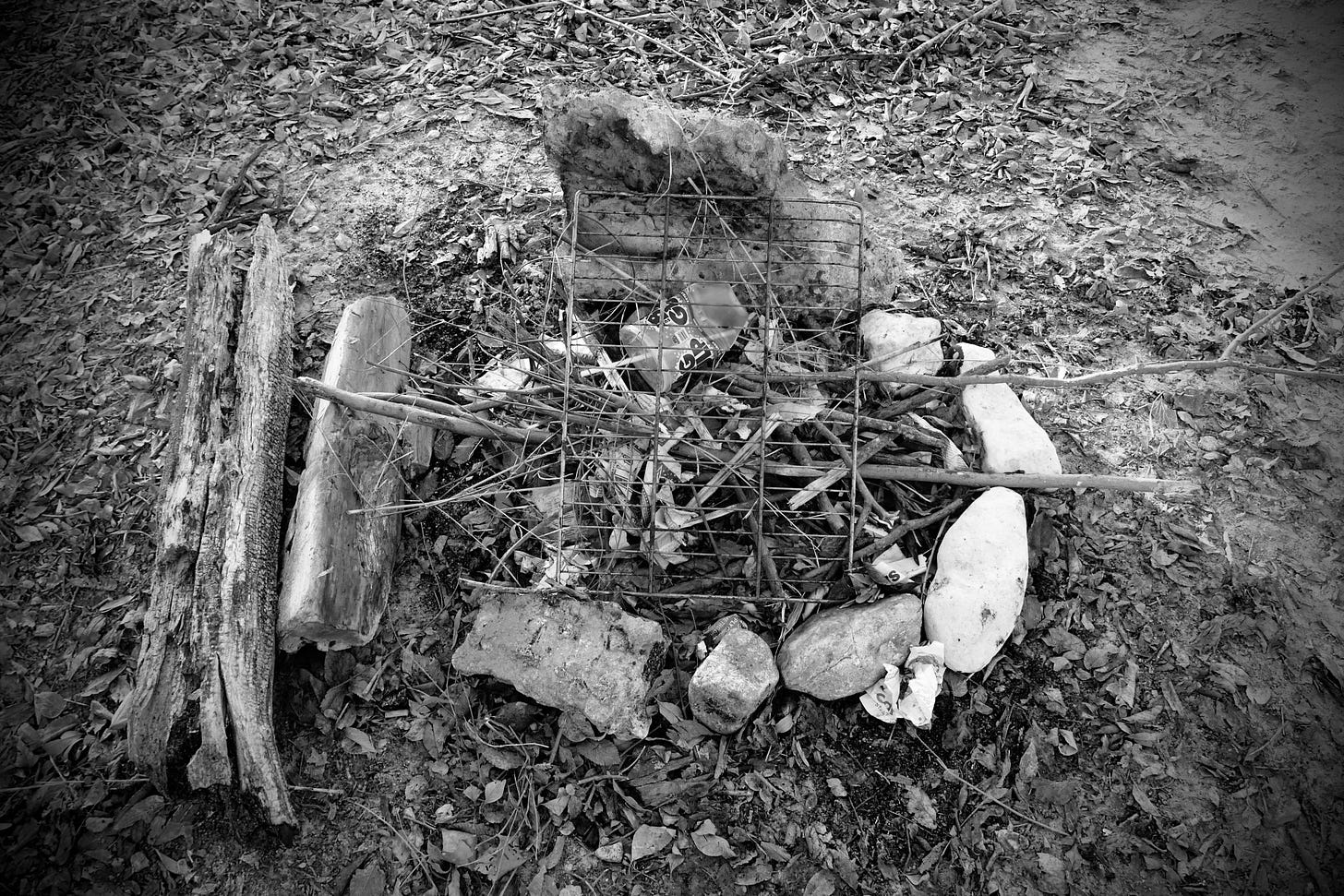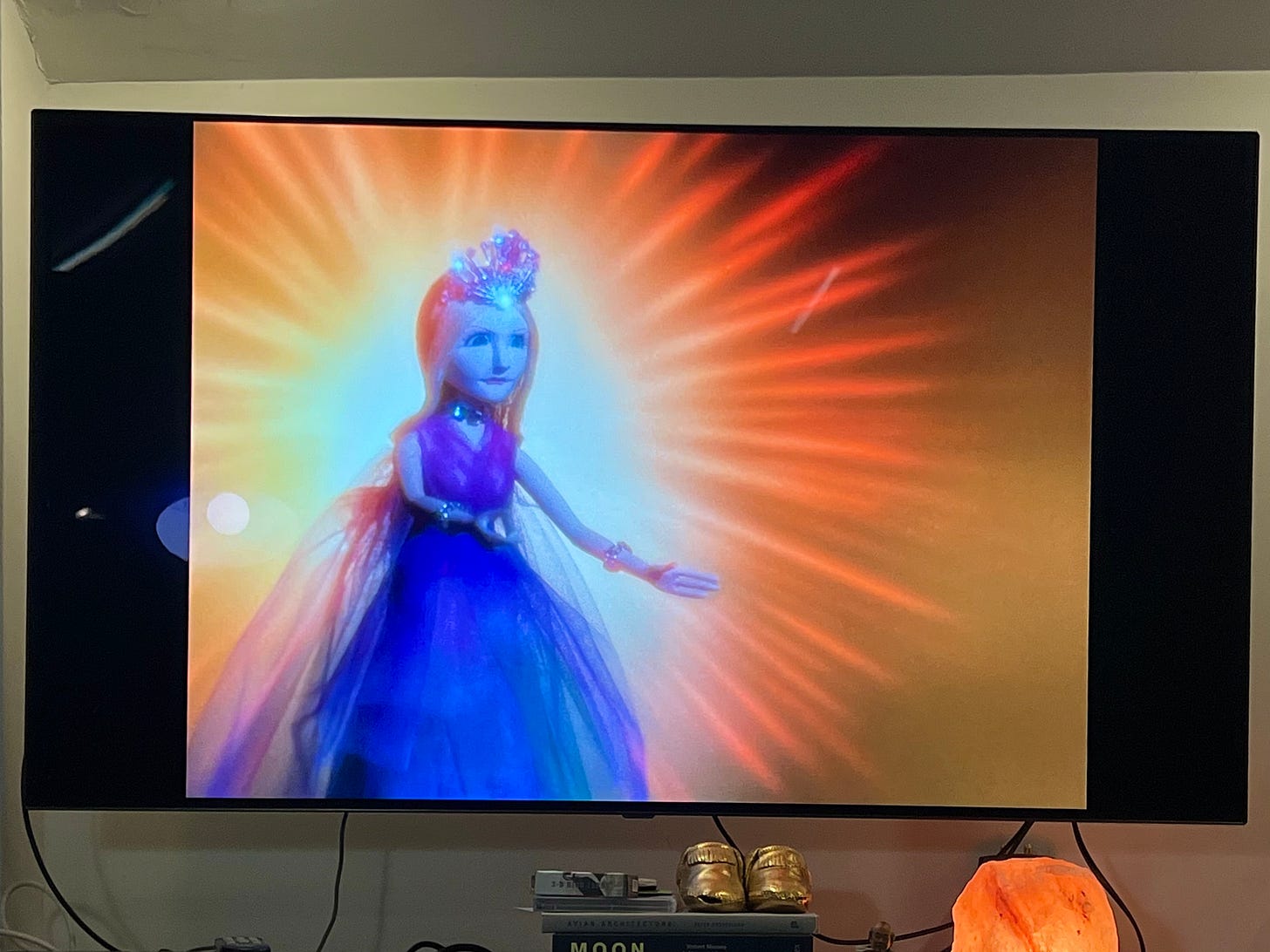White Sycamore and Tasajillo on ice
No. 128
The morning before the cold snap, which was also the morning after the solstice, and the day still consecrated in our calendar to Thor, I walked down to the secret heronry for a welfare check. I hadn’t seen any of the birds in a while, not since they tore down the old metal warehouses where you used to be able to get your muffler replaced and your taxes done in the same spot. I thought maybe they had finally been spooked off by the removal of the windowless building that had largely hidden them from human view, in a tall sycamore grown up in what is basically an island of hundred-year-old trash. But when I looked through the fence, there they were, sitting in their aeries seventy feet or so above the ground, yet almost exactly at the level of the nearby street.
In the past month they have constructed a mock-up of the boutique hotel that will go on that slab, with the windows aimed right at the herons. Maybe that’s why, when I zoomed the telephoto lens at them, I found them looking back at me with the same eyes and beaks that are the last thing the fish sees.
The grade down to the river behind that slab is almost too washed out to walk after the rains of autumn. The first few unsure steps, rock-sized ruins of the twentieth century broke free under my boots and rolled loudly down the hill, spooking the wildlife, and our dog, who watched warily and only followed reluctantly. When we got to the bottom, we could see bigger chunks of trash in the channel—broken storm sewers and old slabs waiting for the flood that will be big enough to wash them away.
The sun was low and strong, and when we found a path over the side channel onto the island, which is bigger than its dimensions, my long simian shadow spooked the egrets before they could even see us. That and the crunch of frozen elephant ears under our feet, the exotic plants whose leaves freeze but stalks endure, feeling more like rubber than vegetable, as if they have learned how to make good use of the plastic bottles slowly decomposing in the muck where they grow.
That afternoon a northern wind blew in, hard and cold, one of those winds that is supposed to stay on the other side of the Red River, because you know Texas is the place where everyone thinks its okay to leave things outside, including water pipes. And before sundown, the birds all seemed to be gone.
Friday morning when I got to the old trailer I use as my home office, the thermometer on the wall at my desk said it was 55° F (12° C) inside, even with the space heaters blasting, conditions that proved a good test of one’s commitment to getting the daily word count in. It kind of suited the material, as it turned out, and when the sun finally started to peek over the roofs of the factories, I bundled up and headed out to experience the stillness. 15° F (-10° C) was the official temp, but it felt colder, even though the wind had mostly moved on. I let our old dog stay back, as she is made for Texas summers, not the winters of the future we have made.
I had an idea to see if I could figure out where the big birds go when it’s too cold to stay in their high-rise nests, but first thought I would do a different sort of welfare check, on the camps that have appeared this year in the labyrinth of giant cane behind the feeder road. The stillness was intense, on a morning when nearly every living thing found it too cold to leave their burrow. The only birds I saw as I set out were sparrows who flushed from the cover as I walked. In the field behind the factories, the Johnson grass was finally frozen down to the base, and as I crunched through it a few big deer moved along the bluffline, looking like their coats had somehow thickened overnight to confront the arrival of real winter.
The encampment back there between the dairy plant and the wildlife preserve was bigger than I expected from what I had seen from the road, though not as big as the developer who wants to turn that empty lot into a high-end mixed use development had suggested in our negotiating session Monday, as a sidewise way of making clear what an improvement his project would be. The camp also seemed empty, recently evacuated, an assuring sign that its inhabitants had taken advantage of warmer shelter.
Walking around the camp’s periphery, I was struck by how elaborate the shelters were, constructed from a mix of bought materials and found. The roofs of several were made from the portable sun shade structures that seemingly every Texan has in the garage, ready to throw in the truck for a trip to the beach. The posts were anchored with good new synthetic rope tied to metal stakes, and from them were draped layers of plastic tarps and cloth draperies, some with patterned prints. Those walls were then reinforced with heavy objects around the base, and in one corner of the encampment something like a rudimentary millwork had been running, with fragments of plywood and found lumber left out, but no tools to be seen.
As I left the camp to head deeper into the woods, I came upon a little shrine. Someone had cut two sections of the cane, painted it pink, and made a cross in a little grove between the tents. The cross was garlanded with purple, yellow & white plastic flowers, and complemented by a potted plant and five decorative yard stakes in a July 4 theme, which you could see were as good as new, bought at a store over the summer. The grass had been cleared from the little area, except for one spot where three small fragments of Astro-Turf had been laid. The only writing you could make out was on one of the stakes, which was topped with a corrugated metal heart that read, in happy cursive, Land That I Love. That was also the only real clue as to what loss the shrine commemorated.
Every time I took my gloves off to take a photo, I could feel how quickly you could get into trouble in those conditions.
In the woods, there were more deer, and more songbirds, especially closer to the river. Cardinals, wrens, and lesser goldfinches. The doves were in the bare trees, seeming even more fidgety than usual, and one osprey finally appeared in the distance over the cold water, silhouette of a fresh catch in its talons.
At the end of the old jeep road, which may have been where the ferry used to cross, someone had been reading ESPN magazine and drinking tall boys of Bud Light by a campfire, the insulation they had been using as a tarp draped over the block of Rebar-pronged concrete they had been using as a stoop, with the magazine open to a picture of Serena. In the fire you could see a torn up bus schedule had been used as kindling, but not lit. Evidence perhaps of someone having readied a fire to stay warm, and then gotten a better idea.
The sand along the banks was frozen, preserving the tracks of earlier in the week, raccoon, coyote, and whitetail. As I followed it upriver, in the direction of home, I finally found some of the bigger birds. Big flocks of ducks, mallards and pintails mostly, clustered in the shallows. Further on, you could see a line of egrets huddled at the waterline of the island, sheltered by the tall reeds, the landmark of the now-empty heronry rising behind it. And with magnification you could see a few of the great blues in there with them.
Some of the newer high rises of downtown were visible further in the background, poking up above the treeline, glistening in the cold morning sun. Making one wonder if we could make a future as simultaneously wild & green and prosperous & advanced as that accidental vignette wanted you to believe you had stumbled into. Or if the future this society will make from its political economy of extraction, and the damaged planet it has bequeathed us, will look more like those encampments, made by people who somehow manage to exist as nomads in the margins of the city while still participating in consumer capitalism and probably the work force. Survivors huddled around artifacts found at the dollar store at the end of the supply chain and the end of the world.
Under my feet as I stood there, I spotted a fossil among the river rock. Ribbed fragment of a shell, probably left by some Cretaceous bivalve sixty-some million years ago, when this was the bottom of a sea. I tried to pick it up, but it was locked in the ice.
Before our Puritan forebears got a hold of it, Christmas was a self-evidently pagan holiday, tied up with the solstice and the season when the last harvest had ended, and the meat, beer and other perishables had to be consumed or preserved to avoid waste. It was also the time when the rules of class and privilege were upended, and rowdies could come knocking at your door for food and drink, and if you turned them away, they had license to trash your place and kick your ass if they were so inclined. In the Roman era, when the solstice was the time of Saturnalia, the masters had to serve the slaves. You can still feel those instincts kicking around in the culture, and it’s not hard to imagine the social utility a revival of those traditions could have as the mid twenty-first century starts to heat up. Maybe next year we can all show up at Elon’s house and knock on the door.
But what I really found myself thinking about as Christmas Eve came around was the ghostly white tree I had encountered deep in those frozen woods, in a spot where the trail had eroded over the summer and I had to bushwhack an alternate route. It was the other side of a spot where I had a close encounter with a barred owl last winter, a curious bowl in the floodplain that might have been formed by a past channel of the river, or by past mineral extraction operations before that zone became an involuntary park. Cirlot lists some of the associations between gods and trees, but does not mention the sycamore, which seems to lose its bark as it matures, perhaps to better express its embodiment of inexhaustible life, life without death, the connection of life with earth and sky. And more simply, of the possibility of peace that nature affirms, especially in the quiet of winter’s cold.
Stocking stuffers
For more on the history of today’s holiday, check out Stephen Nissenbaum’s 1997 book The Battle for Christmas, a social and cultural history that was a Pulitzer finalist.
And for a fresh work of symbology that more deeply explores the confluence of the Christian and the pagan, check out The Bestiary of Christ by Louis Chardonnay-Lassay, recommended to me by a reader after last week’s post.
On the lighter side, in an effort to diversify our daughter’s televisual diet away from princess movies and the Scooby Doo marathons one of her best buddies turned her on to, I downloaded the Rankin & Bass stop-motion animated story of Rudolph. She liked it so much that I went looking for other Rankin & Bass holiday movies, and found there are close to twenty of them. And some of them are really insane narrative jumbles, like Rudolph & Frosty’s Christmas in July, which combines your favorite Gen X holiday characters with a bizarre circus on the beach emceed by Ethel Merman playing a stop-motion cowgirl, young Santa as a skinny red-bearded pioneer roaming a ravaged landscape with blonde wife and elf children in search of a place to settle, a Dick Van Dyke-like ice cream man trying to find his way back in a Montgolfier-looking hot air balloon, and the war between a white-bearded Palantir-wielding wizard and a Galadriel-like goddess who reveals the occult backstory of how Rudolph got his glow, through a spell encoded in a symbol she etches onto the bottom of his right front hoof that channels “the Power of the North Star.” I somehow missed this when it came out in 1979, probably because I was more interested in the pair’s cel-animated adaptation of The Hobbit. Watching Christmas in July makes me dream of the stop-motion Lord of the Rings they probably wanted to make, only to be frustrated by rights issues. What an Island of Misfit Toys that could have yielded.
Merry Christmas to those who celebrate it. Field Notes will be off for the holidays next week. Stay warm and see you in the new year.












This sentence in particular really moved me, "... Survivors huddled around artifacts found at the dollar store at the end of the supply chain and the end of the world."
Thank you for sharing.
Blizzards, sub-zero temperatures, and 40 mph winds across the North Country. We prepare for that, unlike the folks in Texas who shiver and die when the Polar Vortex ruptures. You're prepared; stay warm. Merry Christmas!